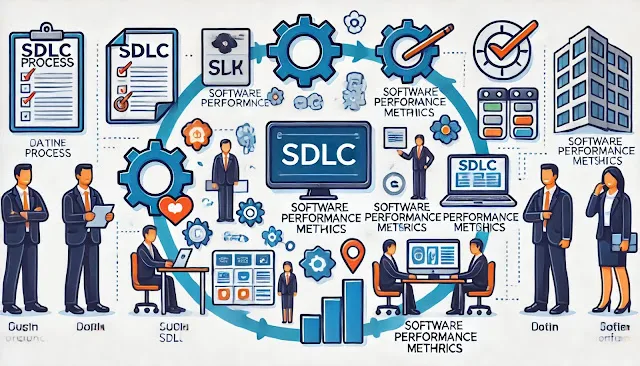The Importance of Mastering the Software Development Lifecycle (SDLC)
Hello, readers! Have you heard about the Software Development Lifecycle (SDLC)? The SDLC is a framework that defines the process used by software developers to design, develop, and test high-quality software. It ensures that each phase of the development process is well-structured and efficient.

|
|
Diagram of the SDLC Process |
In the realm of SDLC, many methodologies have emerged to streamline the development process. Experts like Barry Boehm, known for the Spiral Model, and organizations such as IBM and Microsoft have contributed significantly to the evolution of these practices. These entities have introduced various models, including the Waterfall, Agile, and DevOps methodologies, which cater to different project needs and enhance productivity.
To wrap it up, mastering the Software Development Lifecycle (SDLC) is crucial for anyone in the software industry. Stay tuned for more articles and insights that will help you navigate and excel in this ever-evolving field. Dive deep into SDLC and discover new ways to maximize efficiency in your projects!
This article explores how to navigate each phase of the SDLC with precision and efficiency, introducing best practices to transform your development process from concept to deployment.
What is the Software Development Lifecycle, and Why Does It Matter?
Defining the Software Development Lifecycle
The Software Development Lifecycle (SDLC) is a systematic process used by software developers to plan, create, test, deploy, and maintain software applications. It serves as a blueprint, ensuring the delivery of high-quality products that meet client requirements and user expectations.
Key stages of the SDLC include:
-
Requirement Analysis
-
System Design
-
Implementation
-
Testing
-
Deployment
-
Maintenance
Why SDLC Matters
SDLC is vital for several reasons:
-
Structured Approach: Provides a clear framework to manage projects efficiently.
-
Risk Reduction: Identifies potential issues early, minimizing costly mistakes.
-
Enhanced Quality: Promotes rigorous testing and quality assurance.
-
Customer Satisfaction: Aligns software development with user needs and expectations.
By adopting a well-defined SDLC, teams can streamline operations, optimize resources, and deliver robust software solutions.
Optimizing SDLC for Maximum Efficiency
Use the Right Keywords
Keyword optimization is essential for enhancing communication within teams and external stakeholders. Incorporate terms like "software development lifecycle," "agile methodologies," and "continuous deployment" into:
-
Project documentation
-
Team discussions
-
Client deliverables
Optimize Titles and Meta Descriptions
Incorporate descriptive and actionable titles and meta descriptions to improve search visibility and accessibility. For instance:
-
Title: “Streamline Your Agile Software Development Process”
-
Meta Description: “Discover best practices for managing the software development lifecycle using agile methodologies and modern tools.”
Use Headings Wisely
Headings guide readers through the content and improve overall readability. Key strategies include:
-
Use H2 headers for main sections (e.g., "Why SDLC Matters").
-
Apply H3 headers for subsections (e.g., "Benefits of Agile in SDLC").
-
Incorporate keywords naturally in headings.
Additional Tips for SDLC Success
-
Embrace Agile and DevOps: Foster collaboration and flexibility to adapt to changing requirements.
-
Invest in Training: Equip teams with the latest tools and methodologies for efficient development.
-
Leverage Automation: Use automation tools for coding, testing, and deployment to save time and reduce errors.
-
Monitor Performance: Continuously evaluate software performance and user feedback for improvements.
-
Document Processes: Maintain detailed documentation to ensure consistency and knowledge transfer.
Conclusion: Achieving SDLC Excellence
Mastering the software development lifecycle is not just about following a set of steps; it requires adopting a strategic mindset and leveraging modern tools and techniques. By implementing the strategies outlined here, you can ensure your projects are completed efficiently and deliver maximum value.
Take Action Now: Review your current SDLC practices and identify areas for improvement. The time invested in optimizing your SDLC will pay dividends in quality, efficiency, and user satisfaction.
Frequently Asked Questions (FAQs)
What is meant by software development?
Software development refers to the process of designing, coding, testing, and maintaining software applications to meet specific user needs or business objectives.
What are the 7 stages of software development?
The 7 stages are:
-
Planning
-
Requirements Analysis
-
System Design
-
Implementation (Coding)
-
Testing
-
Deployment
-
Maintenance
Why is mastering the SDLC important?
Mastering the SDLC ensures efficient project management, reduces risks, enhances software quality, and aligns development efforts with user expectations.

No comments:
Post a Comment
Your comments fuel my passion and keep me inspired to share even more insights with you. If you have any questions or thoughts, don’t hesitate to drop a comment and don’t forget to follow my blog so you never miss an update! Thanks.